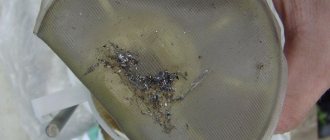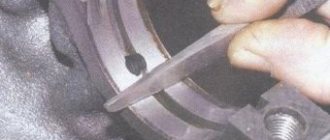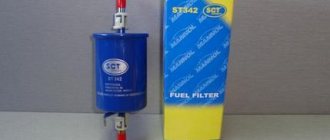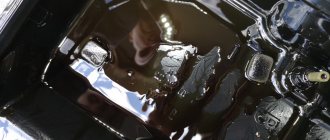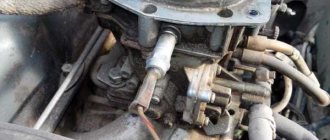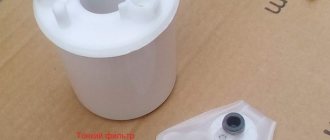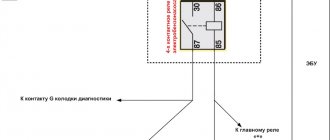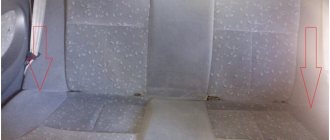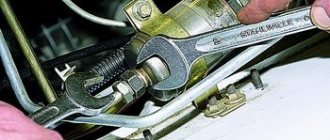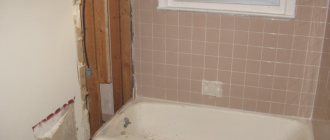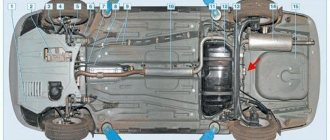There are several signs that indicate that the fuel pump is clogged. Each of them individually may not indicate this one hundred percent, but taken together they are sufficient grounds to begin cleaning. These are the signs:
- the engine stalls when you press the accelerator;
- the acceleration dynamics of the car decreases;
- the engine responds poorly;
- starting with the starter is somewhat difficult;
- When the gas pedal is pressed sharply, jerking occurs.
Depending on how badly the fuel pump is clogged, these problems can vary greatly in scope. For example, if the pollution is very high, then when you press the gas pedal, the car may hardly accelerate.
Cleaning the fuel pump screen can solve these problems, but it is important to remember that there are other reasons that can cause them:
- The injector has failed.
- The fuel pump is not working correctly.
- The fuel filter is dirty.
If the filter and mesh are still easy to change on your own, then for the rest it would be better for a beginner to contact a car service center. This will allow you to avoid gross mistakes that an inexperienced car enthusiast may make during the repair process.
Filter at the inlet of the fuel pump - purpose
It is clear that the main purpose of the filter is to retain various contaminants. The mesh on the Lanos fuel pump (popularly also called a diaper) is a filter element for rough cleaning of fuel. It serves to prevent contaminants from entering the fuel pump.
The absence of a mesh will lead to accelerated failure of the pump. That is why a mesh is installed at the entrance to the gasoline pump to prevent large and medium-sized contaminants from entering the electrical mechanism. After the fuel pump there is another filter, which is designed to clean the gasoline pumped from the tank to the fuel rail. The absence of this filter will lead to accelerated clogging of the injectors and a decrease in their performance.
Instructions for replacing the fuel pump mesh on Chevrolet, ZAZ and Daewoo Lanos, Sens and Chance
It should be noted right away that the resource of this filter element ranges from 50 to 100 thousand kilometers. It all depends on the quality of the gasoline being poured into the tank, but you can refuel once unsuccessfully and, at best, end up having to replace the filter, and in the worst case, you will have to change the fuel pump.
Next, we’ll look at how to replace the Lanos fuel pump mesh yourself, and what you’ll need for this. When carrying out the work, you will need a minimum set of tools, consisting of a flat or slotted screwdriver, steel wire and a hair dryer. To replace the mesh, you will need to remove the entire fuel pump module. How to do this yourself is described in detail in the material on removing the gas tank or instructions for replacing the Lanos fuel pump. The process of dismantling the fuel pump assembly with the mesh must begin by disconnecting the negative terminal of the battery.
https://youtube.com/watch?v=fXUnZuodjlU%3F
After the fuel pump module assembly is removed from the mounting hole of the tank, we proceed to further steps to replace the strainer:
After removing the pump, there will be some fuel left in it, which can be poured back into the tank or container by turning it down with its upper part. We place the entire mechanism assembly on a clean cloth or newspaper, and proceed to replacing the mesh. First of all, you need to dismantle the float, for which you remove the plastic C-shaped clip. To remove the clip, you need to compress it and remove it from its seat. To get to the fuel pump coarse filter, you need to remove the top cover of the plastic flask. It is attached using three protruding slots, which need to be pressed with a screwdriver. Before removing the top cover of the flask, you need to disconnect the power supply connector for the fuel level sensor. This sensor is attached to the outer flask (it is also called a glass). Next, we proceed to dismantling the inner flask with the fuel pump, since the mesh is attached specifically to it. You can dismantle the inner flask using strong steel wire, from which you need to make a hook. An example of such a hook is shown in the photo below. The hook is needed to dismantle the inner flask (with the fuel pump), to which the mesh is attached. This flask is fixed using an internal protrusion along the circumference on the outer flask. The photo below shows a protrusion in the inner part of the outer flask, through which the fuel pump bracket with filter is fixed. To simplify the process of dismantling the inner flask, you need to heat the walls of the outer bowl with a hair dryer
This will lead to its expansion, which will allow you to easily and quickly remove the flask (it is important not to overdo it with a hairdryer). Using a hook, you need to grab onto the plastic protrusion on the inner flask and pull towards you (moderately). To increase the effectiveness of actions, efforts should be made alternately at several points
As a result, the inner flask with the gas pump and the mesh located in the lower part is removed. It is this mesh that will have to be replaced, having previously assessed its condition. In 100% of cases, the inside of the outer flask will have contaminants that should be removed. We proceed to removing the mesh, for which the first step is to remove the retaining ring (washer) by prying it off with a screwdriver. Remove the old filter, replace it with a new one, and secure it with the retaining ring. It is recommended to purchase a new ring, since when it is removed, the quality of fixation has significantly decreased. If you install the old ring, then there is a high probability that the mesh may come loose during operation. We install the Lanos gas tank mesh in place and carry out the assembly in the reverse order.
The procedure for replacing the gas tank mesh is not difficult, but it is very responsible, since the work is carried out with parts that are coated with highly flammable substances.
After assembling and installing the fuel pump with the new element in place, you can put the negative terminal on the battery and turn on the ignition. When the pump pumps gasoline and turns off, you can start the engine. This completes the process of replacing the fuel pump mesh.
This is interesting! Two types of fuel pump modules TA and TG were installed on Lanos. The principle of replacing the mesh on TG type devices is discussed above. Blocks of the TA type differ in that the mesh on them is located on the outside. You can read more about the differences between the modules.
https://youtube.com/watch?v=KIs_mGTSxUA%3F
Fuel filter cleaning steps
If you decide to clean the fuel filter yourself and the dismountable filter, follow the following step-by-step instructions.
To find the fuel filter, you need to look at the fuel line from the carburetor or fuel injector. This is usually a small plastic or metal part.
Next you need to disconnect the hose clamps. When the clamps are loosened, you need to pull out the hose from the fuel filter and drain the excess fuel into a container. When the filter is empty, remove any remaining fuel using a dry, lint-free cloth.
- Wash the fuel filter on both sides with kerosene, solvent or acetone and knock off any remaining debris on any hard surface. It also doesn't hurt to blow out the fuel filter with a tire pump.
- Repeat the process until the fuel filter is in acceptable condition.
- Make sure the gaskets are in good condition. Replace them if necessary.
- After cleaning the fuel filter, let it dry and then reinstall it. If the filter is damaged, has perforations or cracks, you better replace it.
When and why you need to change/clean the fuel pump screen
Let's start with the fact that general problems with the fuel system (fuel pump in particular) should be divided into the most common groups:
- the fuel pump mesh and fuel filter are clogged;
- the fuel pump itself has failed;
- injector problems;
Let us add that we should also not exclude the possibility of air leaks, that is, airing of the power system. Another culprit of problems may be the pressure regulator in the fuel rail. In this case, engine malfunctions may be partially similar to some of the symptoms mentioned above. For example, a slight ingress of air into the fuel system results in the engine not starting for a long time after parking.
Let's go back to the fuel pump. Its malfunction means that the performance of the fuel supply system is reduced. If the fuel pump breaks down, then the car becomes unsuitable for normal use. Signs of a fuel pump malfunction are as follows:
- It is impossible to start the engine, the fuel pump does not pump;
- the engine starts, but runs with serious interruptions;
In this case, the service often recommends diagnosing, repairing or replacing the fuel pump. It should also be taken into account that the fuel pump mesh filter may become clogged inside the device. Let us immediately note that it is impossible to accurately answer the question of when to clean the fuel pump stack. Some car enthusiasts clean/replace the fuel pump mesh as needed or as a preventative measure every 50-70 thousand km. mileage, while others are faced with the need to clean the fuel pump grid for the first time at mileages of 150 thousand km or more. and more. Let us add that the operating manual for some models specifically states that it is recommended to replace the fuel pump stack once every 120 thousand km.
It should be added that the loss of dynamics and the appearance of symptoms of a clogged mesh occurs gradually. For this reason, each driver decides to clean the fuel pump himself. On powerful naturally aspirated engines, the gradual deterioration in acceleration is not felt as strongly as compared to highly accelerated engines with a small displacement. For this reason, many owners of large-volume trucks begin to solve the problem after noticeable complications appear. Also, the condition of the pump grid is greatly influenced by the quality of the fuel being filled and a number of other factors and individual operating conditions, which we will talk about a little later.
Fuel pump device
Modern cars use two types of fuel pumps - mechanical or electric . The former are used in carburetor engines, the latter in injection engines.
The mechanical pump is usually installed on the body of the gas tank, while the electric pump is installed inside the tank. Some automakers use both types of pumps at once.
Mechanical pump
The mechanical fuel pump is quite large. Its main elements are:
fuel chamber;
inlet valve;
release valve;
diaphragm return spring;
When power is applied to the fuel pump, the lever begins a repetitive up and down motion. Due to these movements, the diaphragm moves, and gasoline flows first into the pump and then into the engine.
This is how fuel is supplied in carburetor-type engines. Since the distance between the carburetor and the fuel pump is usually small, such devices can supply fuel even at minimal pressure.
A mechanical fuel pump is usually installed on the body of the gas tank
Electric pump
Electric fuel pumps are small in size and have a simple design. Inside the pump housing are:
chamber for gasoline;
inlet valve;
release valve;
diaphragm return spring;
The main element of an electric pump is the core. Due to the additional valve, it performs reciprocating movements and opens the valves for fuel inlet and outlet. Such a pump only works when the fuel pressure in the system is high and gets very hot while the car is moving. For more efficient cooling, it is usually mounted in the gas tank.
The electric fuel pump is small in size and simple in design.
How does a fuel pump work?
The fuel pump is powered by the power unit. When the engine starts, the on-board computer signals the fuel system about the need to supply fuel. Electricity is supplied from the engine to the fuel pump, and a small motor inside the pump creates the necessary pressure in the system. In the first few seconds after starting the car, you can hear the fuel pump humming as it pumps gasoline.
A certain amount of fuel enters through the inlet valve into the pump chamber, then through the outlet valve into the fuel filter. There, the fuel is cleaned of dirt and impurities and sent to the engine. The fuel pump turns off automatically, along with the engine.
Cleaning the fuel pump mesh
As you know, the engine is the most important component of a car. The main element of supplying the working mixture to the engine system is the fuel pump, which is responsible for supplying gasoline to the filter element and subsequently to the combustion site.
The period of operation of engine system elements and the fuel pump, among other things, is influenced to a large extent by the quality of the fuel mixture. In frequent cases, the use of insufficiently purified gasoline leads to dysfunction of the vehicle. If the fuel pump is clogged, the car begins to move jerkily or does not start at all.
The first step in restoring the function of the car, in this case, is replacing the fuel pump grid.
During the operation of the car, the fuel pump mesh becomes quite clogged and its condition can surprise even an experienced car enthusiast.
Signs that a Renault Logan fuel pump needs to be replaced
Failure to carry out this procedure in a timely manner can affect not only driving comfort, but also the condition of the engine and many vehicle systems. There is no need to talk about safety, given that the driver may get into an accident if the engine stalls on a busy highway. So you should pay attention to the slightest signs of fuel pump failure.
Among these are:
Do-it-yourself fuel pump screen cleaning.
To carry out the work, you need to stock up on the following materials:
- Compressor.
- Fuel pump gasket.
- Nozzle seal.
In order to clean the hard filter, it is necessary to dismantle the fuel pump.
- Turn off the car's power source.
- Unscrew the holders and remove the cover.
- We remove the electric drive.
- We disconnect the fitting and the conductor through which the fuel circulates.
- We also remove the fitting and remove the fuel outlet hose.
- Remove the seal.
- Raise the gasoline compressor and remove the float. Next, together with the mixture level analyzer, we dismantle the fuel pump.
- At the bottom of the pump there is a mesh (coarse filter).
It is quite difficult to determine the contamination of the mesh by visual inspection. Small particles can interfere with the proper functioning of the fuel, while remaining almost unnoticeable. To successfully wash the mesh, you need to let it soak in a special solution. To do this, you need to dilute the detergent one to ten with water. Next, you need to place the mesh in a tank with the prepared composition and leave it there for one hour.
After this, you can proceed to the main cleaning stage.
- To do this, uses the same composition and a brush with fine bristles. Using the specified materials, thoroughly rinse the mesh.
- After this, you need to clean the filter with a stream of air. To do this, we use a compressor.
- Next, you need to wait until the filter is completely dry. After which, you can assemble the fuel pump.
After washing the element, it is necessary to carry out repeated visual diagnostics. The network must not have mechanical damage. Otherwise, further use of the element is impossible and the filter must be replaced.
After completing all stages of work, we assemble the fuel pump in the opposite order. Next, you need to check the correct operation of the fuel system and the success of the operation.
https://youtube.com/watch?v=xnKwDtCtM_0%3F
During the operation of the car, it is necessary to promptly pay attention to malfunctions in the fuel system and regularly replace used filters. Happy renovation!
Happy renovation!
Replacing the mesh on a VAZ 2110-VAZ 2112
Removal:
1) We talked about cars with a 1.5 liter engine above.
2) Now let's talk about 16-valve cars. Remove the pump, take a screwdriver and remove the retaining ring from the guide (often called the pin). There is only one ring, although there are two guides. It is removed as follows: pry it with a screwdriver and move it to the end of the guide in the direction of the blue arrow in the photo until it is completely removed. Now the main thing is not to turn the fuel pump over, otherwise the housing will fly out spontaneously and the hoses may break.
3) The photo below shows two blocks with wires; they need to be disconnected. If you pull with force and they do not give in, then you are doing something wrong and there is a possibility of breaking the clamps. Press the retaining clips and carefully remove them.
4) Grab the top of the fuel pump with your hand and separate the two housings along the guides. Put one housing aside, continue to hold the gas pump in your hands and use a screwdriver to disconnect the mesh. Remove it and replace with a new one.
Installation:
Proceed in the reverse order of removal. Make sure that the part is securely fixed; it should not fall off. We recommend that you take your time and do not install the fuel pump flap with the rear seat cushion, but rather ask an assistant to turn the key in the ignition for about 5 seconds, and you watch to see if gasoline flows from under the fuel pipes. The tightness of the system is mandatory; in case of malfunctions and leaks, replace worn parts with new ones.
Additional video: Attached below is a video using the example of a VAZ 2114 on the topic of today’s article, we recommend you watch it.
Note!
The video below shows the procedure for disconnecting the wire block; if you have difficulties with this, it is useful to watch:
Replacing the fuel pump mesh for Skoda Octavia
I recommend that all Skoda Octavia owners select the mesh according to the fuel pump number, which is stamped on top of the fuel section. There are several options for collapsible and non-demountable structures. In my case, the filter in the form of a flask beats by number. The Skoda Octavia fuel pump is located in the tank; access to it appears after tilting the right side of the rear row of seats.
1. Replacing the Skoda Octavia A5 fuel pump begins with thoroughly cleaning the fuel section. Otherwise, some of this dust and dirt will end up in the tank. This can be done with a vacuum cleaner and a regular brush.
2. Using small blows into the grooves along the inner edge, unscrew the pressure plate counterclockwise. Place a mark on the fuel module body and tank to facilitate positioning of the section during installation.
3. Pull the section out of the tank so as not to bend the float rod of the fuel level meter. Before starting disassembly, pour all gasoline from the flask.
4. Unscrew the 4 screws securing the coarse mesh housing.
5. Disconnect the motor power terminals. Pull off the fuel pump fuel pipe clamp. In the original, a disposable clamp is installed on the car. In my case, I didn’t have one at hand, so I had to install a regular one during assembly. Before removing the handset, warm it up with a hairdryer.
6. Unclip the 3 plastic clips connecting the cover and the bottom of the fuel section.
How to clean dirt from the fuel pump screen?
You will need:
#1
In some car models, the gas tank is located under the passenger seat. To work, you need to prepare the following tools: carburetor cleaner, gloves, wrenches, screwdrivers, a flashlight, a pump (electric or mechanical) that will be powered by another machine, a marker, WD40 in case the bolts and nuts stick, and a fire extinguisher. You should remove the fuel pump fuse and start the car engine (it will stall after a couple of seconds) before cleaning the fuel pump screen. This is done to prevent gasoline from spilling into the passenger compartment. It's better to play it safe and leave the tank half empty. After releasing the pressure, you can remove the battery terminals. Between the rear seats, or more precisely, under them, there is the right gas tank door (hatch).
#2
After unscrewing the bolts, it can be easily removed. From here you can see the fuel level sensor, to which two power connectors and two hoses are connected. One of them is for the fuel pump. If it is particularly dirty, you can vacuum it. You can learn from specialists how to clean a fuel pump mesh or how to knit a fishing net and solve the problem yourself. After cleaning the devices, connectors and hoses must be removed. The hoses can be marked with a marker; it is better to plug the holes in their place. After unscrewing the bolts, the structure is removed. However, you should be careful not to damage the sensor float, which is located on the side. Now you can see the tank with gasoline inside. It is better to disconnect the power connector going from the fuel pump to the sensor for convenience. You can learn how to tension a chain-link mesh from the article on the corresponding website. You need to put on a rubber glove and put your hand into the gas tank. You need to find the fuel pump, a latch that should be pressed and then pull the fuel pump towards the hood. Sliding along the slide, the fuel pump comes out of the tank. If there is gasoline, it will pour out for a while, so it is better to hold it over the tank. The fuel pump is located inside a plastic shell - it can be easily disassembled into two parts using latches. Sometimes it is necessary to replace the mesh.
#3
You can also learn how to change the mesh on the fuel pump from this article. The small pink bag is the fuel pump filter. Dirt accumulates on the outside of the filter mesh. Sometimes there is so much of it that it is easier to change the grid itself. Replacement is easy and can be done in five minutes. Dirt should be removed using carburetor cleaner. Assembly is carried out in reverse order. Sometimes it is difficult to place the fuel pump back into the tank and place it on the skid at the very bottom. You can learn how the mosquito net is attached and how to change the net on the gas pump by wisely using the information search system on the World Wide Web. Care must be taken to carry out the entire process from start to assembly. If you follow the instructions and sequence of actions, the car begins to work much better: acceleration is optimized, noise disappears. If the problems cannot be resolved on your own, it is better to contact a specialist. Perhaps the reason is something else.
uznay-kak.ru
How to change the filter on a fuel pump
The mesh in the fuel pump design is a coarse filter for the fuel pump. The fuel pump mesh filter is necessary for pre-cleaning of gasoline, which is pumped from the gas tank into the fuel supply line of the fuel injection system. In other words, when fuel is pumped in, it first passes through the pump mesh, after which it is further cleaned in the fuel filter, and only then is supplied to the engine.
Like any other filter, this mesh becomes clogged over time with small particles, dirt and deposits that are in the fuel and gradually accumulate in the gas tank. A decrease in the capacity of the fuel pump grid leads to the fact that gasoline is poorly pumped, the engine starts with difficulty or does not start, the car jerks during acceleration and drives jerkily. The load on the fuel pump itself also increases, making it more difficult for it to create and maintain the required pressure in the system. When these symptoms appear, one of the available solutions is the ability to change the mesh in the fuel pump with your own hands.
Replacing the fuel pump mesh with your own hands
Let's start with the fact that in some cases, many car enthusiasts decide to clean the fuel pump mesh, especially when a new filter is difficult to find on the open market. Note that after cleaning the fuel pump screen, it is possible to remove a significant part of the contaminants, although the optimal way remains to replace the fuel pump screen with a new one. The fact is that it will not be possible to completely remove dirt. Also, cleaning is often impractical, since the cost of a new fuel pump mesh is usually quite affordable (about 2 USD for meshes for VAZ family cars);
Replacing the fuel pump filter is a procedure that should preferably be performed every 50-100 thousand km. mileage To replace the fuel pump filter you need a minimum set of tools:
- set of wrenches;
- screwdrivers;
- tubular keys;
Let us add that there is no need for an inspection hole or a lift, since access to the fuel pump is provided from inside the car. On most cars, the fuel pump is installed under the rear seat; the fuel pump screen is located in the pump housing itself, located in the lower part. It turns out that it is possible to remove the fuel pump filter only after removing the fuel pump from the gas tank and disassembling its housing (if necessary).
The entire process of replacing the fuel pump mesh in general terms is as follows:
- removing the rear seat to provide access to the pump;
- decrease in pressure in the fuel line;
- disconnecting the battery terminal and the power supply from the fuel pump;
- removing the fuel lines and removing the fuel pump;
- dismantling the pump mesh and replacing it with a new filter;
- assembly in reverse order;
How to properly remove the fuel pump yourself
Now let's look at how to replace the fuel pump stack yourself using the example of a VAZ 2110 car. Let's add that these steps have to be performed if you need to change or repair the fuel pump. The difference is that when replacing, the float and fuel level sensor in the gas tank are removed from the old pump, after which these elements are moved to the new fuel pump.
- The gas tank of this car is located in the rear under the bottom. The fuel pump is installed in the upper part of the tank and can be reached from the passenger compartment. To gain access, it will be enough to remove the rear sofa and free up space.
- Then you need to prepare an open-end wrench (13 and 17), a Phillips screwdriver and a long tubular type socket wrench for 7. You can also use a short open-end wrench instead of a tubular one, but it is more difficult to work with such a tool.
- Before removing the fuel pump, be sure to remove the negative terminal from the battery, after which you need to reduce the pressure in the fuel line. To lower the fuel pressure, you need to contact the fuel rail (rail). In the area of the side injection nozzles there is a special valve closed with a rubber plug. The plug should be removed, then place a small container and press on the valve stem. After this, gasoline will begin to flow out, which will lead to the release of pressure in the system.
- Then we return to the salon. Under the chair you can see a square-shaped lid, which is screwed on with self-tapping screws. Under this hatch there is a fuel pump. Use a Phillips screwdriver to unscrew the screws, after which you should disconnect the electrical connector of the fuel pump. This connector can be moved to the side for convenience.
- Now you need to take an open-end wrench and loosen the nuts with which the fuel line tubes (“supply” and “return”) are attached to the fittings on the pump. Then you will need to pull the tubes out of their seats. Please note that there are O-rings at the ends. It is better to replace these rubber rings with new ones, since they are not originally designed for re-installation.
- After removing the pipes, you will need to unscrew the nuts necessary to secure the flat flange that presses the fuel pump to the body.
A tubular wrench is suitable for unscrewing. After unscrewing the nuts, the flange should also be removed from the special mounting studs. You should also pay attention to the rubber gasket ring, which is installed under the clamping part. The specified gasket is also removed from the studs. If you don’t remove it, then you simply won’t be able to remove the fuel pump. After this, the gasket should be inspected and its condition assessed. If defects are detected, this element must be replaced. - Now you can remove the fuel pump from the gas tank. The pump will come out along with the float. Be prepared for some gasoline to leak out of the pump housing when you remove it. For this reason, it is recommended to lay rags inside the cabin and prepare a wide container outside. After removing the pump, it should be carefully and quickly removed from the car outside, placing it above the container.
Installing the fuel pump filter and reassembling
On the VAZ 2110 fuel pump, the filter mesh is secured with a plastic ring. The fuel pump mesh is located at the end of the tube through which the pump sucks fuel from the tank. The fuel pump coarse filter is usually easy to remove. If you have any difficulties, then you can pry off the ring using a flat-head screwdriver.
Now you can begin installing the new fuel pump grid. To secure the mesh, you must press the lock all the way. You should additionally check the reliability of fastening, since the stack should not dangle.
Upon completion, reassembly is carried out, during which you should take into account the correct location of the fuel pump according to the special arrow indicators. In the case of the car in question, the arrow is stamped on top and should be directed towards the rear of the car. Let us add that the clamping part must be screwed on with nuts so as to prevent distortion. When tightening all fuel pump fasteners, be sure to follow the recommended torque.
The final step is to check the functionality of the fuel pump with a new mesh. The engine should start normally and idle stable. It is also necessary to carry out a test drive, during which you should evaluate the behavior of the car in transient conditions, when you sharply press the gas pedal, during engine braking, etc. If the jerking, jerking and dips disappear, then the obvious cause of the malfunction was a clogged fuel pump screen.
krutimotor.ru
